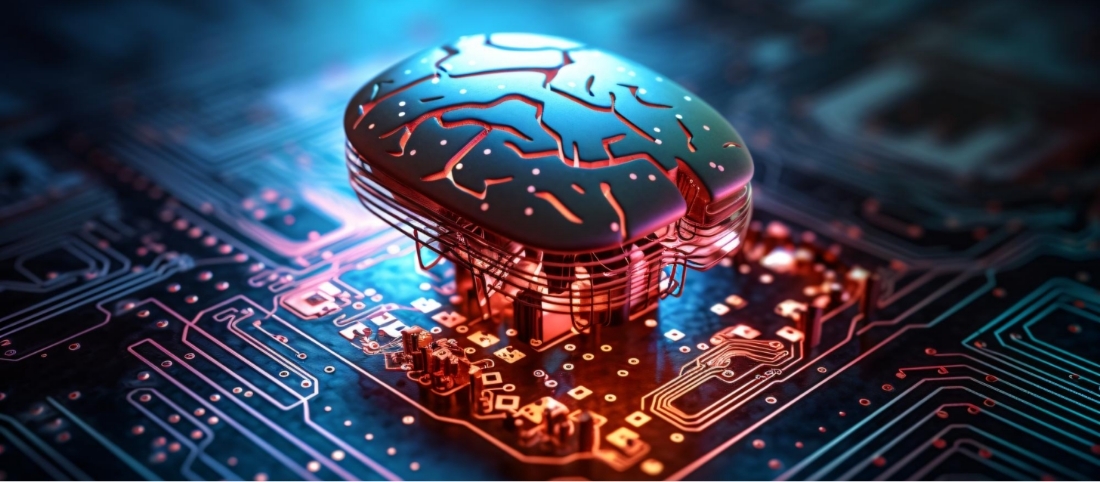The neuromorphic revolution: A guide to next-generation computing
Published March 15, 2024. 1 min readIntroduction
In modern technology, the landscape of computing is continuously evolving. From traditional computational methods to groundbreaking innovations like artificial intelligence (AI) and machine learning (ML), the quest for more efficient and powerful computing systems is unceasing. Among the latest advancements targeted at revolutionizing the field is neuromorphic computing, a model inspired by the human brain's neural networks. In this comprehensive guide, we delve into the intricacies of neuromorphic computing, exploring its significance, applications, and implications for the future of computing.
Understanding neuromorphic computing

Neuromorphic computing represents a departure from conventional computing architectures by emulating the brain's neural structure and operation. Unlike traditional systems that rely on binary logic and centralized processing units (CPUs), neuromorphic systems leverage interconnected networks of artificial neurons to process information in a manner akin to the human brain. These systems are designed to perform complex tasks such as pattern recognition, sensory processing, and decision-making with remarkable efficiency and adaptability.
Key components and principles
At the heart of neuromorphic computing lie architectures and fundamental principles that emulate the complex workings of the human brain. By harnessing the power of interconnected artificial neurons and synapses, neuromorphic systems achieve unparalleled computational efficiency and adaptability. In this section, we delve into the key components and principles that underpin the neuromorphic revolution, shedding light on the innovative hardware designs and computational strategies driving this transformative technology forward.1. Neuromorphic chips:
- Neuromorphic chips serve as the cornerstone of neuromorphic computing, comprising millions of artificial neurons and synapses.
- These specialized hardware platforms are designed to emulate the behavior of biological neurons, including generating and propagating electrical signals.
- Neuromorphic chips leverage advanced semiconductor technologies to achieve high density and energy efficiency, enabling complex neural networks to be implemented on a single chip.
- At the heart of neuromorphic chips are artificial neurons, computational units that mimic the functionality of biological neurons.
- Artificial neurons receive input signals, perform weighted summations, and generate output signals based on activation functions.
- Synapses, the connections between neurons, are crucial in facilitating communication and information processing within the neural network.
- These artificial synapses exhibit synaptic plasticity, allowing them to adapt and learn from input patterns over time—a key feature inspired by the brain's ability to strengthen or weaken synaptic connections through experience.
- Neuromorphic computing harnesses the power of parallelism to perform multiple computations simultaneously, mirroring the distributed processing capabilities of the human brain.
- By exploiting sparsity, which refers to the sparse activation of neurons in response to stimuli, neuromorphic systems can conserve energy and computational resources.
- Unlike traditional von Neumann architectures, where processing and memory are physically separated, neuromorphic systems integrate memory and computation within each neuron, enabling seamless information processing without data movement bottlenecks.
- One of the distinguishing features of neuromorphic computing is its event-driven processing model, where computations are triggered by input events or spikes.
- Rather than operating on fixed clock cycles like traditional CPUs, neuromorphic systems react dynamically to incoming stimuli, enabling real-time, asynchronous processing.
- Event-driven processing minimizes energy consumption by activating only the neurons relevant to the current task, leading to significant gains in efficiency and responsiveness.
- Neuromorphic computing relies on bio-inspired learning algorithms inspired by neuroscience and cognitive psychology principles.
- These algorithms, such as spike-timing-dependent plasticity (STDP) and reservoir computing, enable neuromorphic systems to learn from experience, adapt to changing environments, and perform complex tasks with minimal supervision.
- By mimicking the brain's ability to learn from sparse, temporally correlated input patterns, neuromorphic systems excel at tasks such as pattern recognition, anomaly detection, and associative memory retrieval.
- The scalability and modularity of neuromorphic architectures are essential for accommodating the increasing complexity of neural networks and applications.
- Researchers are exploring hierarchical architectures and network-on-chip designs to scale neuromorphic systems to millions or even billions of neurons.
- Modular neuromorphic architectures allow for the integration of specialized processing units tailored to specific tasks, such as vision processing, language understanding, or motor control, enhancing versatility and efficiency.
Applications across industries
The potential applications of neuromorphic computing span a diverse array of industries, promising transformative impacts in fields ranging from healthcare and finance to robotics and autonomous vehicles.
- Healthcare: In the healthcare sector, neuromorphic systems offer significant potential for accelerating medical diagnosis, drug discovery, and personalized treatment regimens. For instance, researchers at the University of Manchester are leveraging neuromorphic hardware to develop advanced brain-computer interfaces (BCIs) for individuals with neurological disorders. These BCIs enable direct communication between the brain and external devices, empowering patients with disabilities to control prosthetic limbs or communicate with assistive technologies more intuitively.
- Finance: Neuromorphic computing holds promise for enhancing various financial applications, including risk assessment, fraud detection, and algorithmic trading strategies. For example, financial institutions like JPMorgan Chase are exploring the use of neuromorphic hardware to optimize trading algorithms and analyze market data in real time. By leveraging the parallel processing capabilities of neuromorphic systems, these institutions aim to gain a competitive edge in the fast-paced world of high-frequency trading while minimizing latency and operational costs.
- Robotics and Autonomous Systems: In robotics and autonomous systems, neuromorphic computing enables machines to perceive and interact with their environment more intuitively, facilitating tasks such as object recognition, navigation, and natural language processing. One notable example is the development of neuromorphic vision systems for autonomous vehicles by companies like Tesla and Waymo. These systems leverage spiking neural networks to process visual information in real time, enabling vehicles to detect and react to hazards on the road with greater speed and accuracy.
- Edge Computing: With the advent of neuromorphic hardware accelerators, edge computing applications stand to benefit from enhanced intelligence and efficiency. For instance, companies like IBM are exploring the use of neuromorphic processors in edge devices for real-time analytics and decision-making. By deploying neuromorphic systems at the network edge, organizations can process sensor data locally, reducing latency and bandwidth requirements while preserving privacy and security.
- IoT and Smart Cities: Neuromorphic computing can revolutionize the Internet of Things (IoT) and smart city initiatives by enabling intelligent sensing, monitoring, and control systems. For example, researchers at the University of California, Berkeley, are developing neuromorphic sensors capable of detecting and classifying environmental pollutants in real-time. These sensors leverage event-driven processing to analyze sensory data efficiently, enabling early detection of pollution incidents and informing proactive environmental management strategies in urban areas.
Synergies with artificial intelligence and machine learning

Neuromorphic computing intersects with the broader domains of AI and ML, offering novel approaches to training and inference tasks. Unlike traditional deep learning frameworks that rely on centralized data processing and backpropagation algorithms, neuromorphic systems excel at distributed, event-driven computation, making them well-suited for real-time, energy-efficient inference tasks.Furthermore, neuromorphic architectures hold promise for advancing the quest for artificial general intelligence (AGI), a form of AI capable of performing any intellectual task that a human can. By emulating the brain's neural connectivity and plasticity, neuromorphic systems exhibit greater resilience to noisy data, adaptability to novel environments, and potential for self-learning—a crucial step toward achieving AGI.
Challenges and opportunities:
Despite their immense potential, neuromorphic computing systems face several challenges on the path to widespread adoption. One significant hurdle is the development of scalable hardware architectures capable of accommodating the complex connectivity patterns and synaptic plasticity observed in biological neural networks. Additionally, the design of efficient programming models and algorithms tailored to neuromorphic hardware remains an ongoing area of research.Nevertheless, the field of neuromorphic computing presents vast opportunities for innovation and discovery. As researchers continue to refine hardware designs, algorithms, and applications, the potential for unlocking unprecedented computational capabilities and understanding the mysteries of the human brain grows ever closer.
The future of neuromorphic computing
In the quest for next-generation computing paradigms, neuromorphic computing stands at the forefront of innovation. By emulating the brain's neural architecture and computational principles, these systems offer a glimpse into a future where machines possess human-like intelligence, adaptability, and efficiency. One of the most exciting prospects for neuromorphic computing lies in personalized medicine—a groundbreaking approach to healthcare that tailors medical treatments and interventions to the unique characteristics of each patient. Traditional medical practices often adopt a one-size-fits-all approach, prescribing standardized treatments based on population averages rather than considering the diverse genetic, physiological, and lifestyle factors that influence an individual's health outcomes.Imagine a future where healthcare providers leverage neuromorphic systems to analyze vast repositories of patient data, including genomic profiles, medical imaging scans, electronic health records, and real-time sensor data. By integrating these disparate sources of information and applying advanced machine learning algorithms, clinicians can gain unprecedented insights into each patient's unique health profile, disease trajectory, and response to treatment.For example, consider a patient presenting with symptoms of cardiovascular disease. Through sophisticated analysis of the patient's genetic makeup, medical history, and lifestyle factors, a neuromorphic system could identify underlying genetic mutations associated with increased cardiovascular risk. Based on this insight, the system could recommend tailored interventions such as lifestyle modifications, targeted drug therapies, or preventive screenings to mitigate the patient's risk and optimize their long-term health outcomes.As advancements in neuromorphic hardware and software continue to accelerate, the possibilities for reshaping industries, solving complex problems, and unlocking the mysteries of intelligence are limitless.
Conclusion
The neuromorphic revolution represents a paradigm shift in computing, ushering in unprecedented intelligence and efficiency. With its potential to revolutionize industries, advance AI and machine learning, and unlock the secrets of the human mind, neuromorphic computing holds immense promise for the future of technology. As researchers and innovators push the boundaries of what's possible, the journey towards artificial general intelligence and beyond is propelled ever forward by the power of neuromorphic computing.To learn more about how EnLume's innovative solutions can revolutionize your business, visit our website at www.enlume.com. Discover the power of next-generation computing and unlock new possibilities for growth and success.
